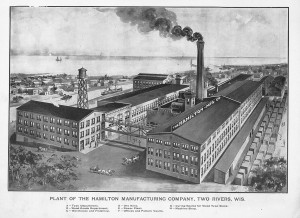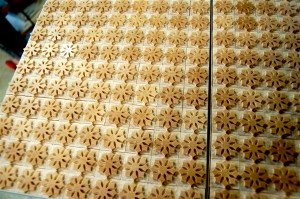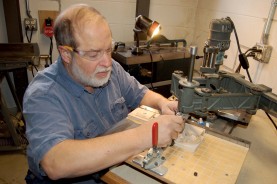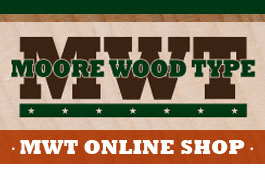
After a very long wait there is finally New Wood Type in the MWT Online Shop!
Click on the window on the right to see the new wood type. Be sure to select the ALL button to see the twelve new items.
I will be posting another ten new items in the near future. – Scott
 For the past six months I have been a member of a shared Technology Group in Central Ohio. One of the workshops I have taken is how to use the group’s 60 watt laser. Just like the learning curve to using a pantograph to cut wood type, it has been another learning curve to integrate the laser into making wood type.
For the past six months I have been a member of a shared Technology Group in Central Ohio. One of the workshops I have taken is how to use the group’s 60 watt laser. Just like the learning curve to using a pantograph to cut wood type, it has been another learning curve to integrate the laser into making wood type.
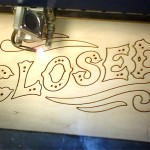 I now use the laser to cut out my patterns in 1/4” baltic birch plywood that I did cut with woodworking tools. I still use the same vector art files I used to make the vinyl sign making material patterns in the past. However, I have discovered that the laser cut patterns are smoother and more accurate on long straight lines.
I now use the laser to cut out my patterns in 1/4” baltic birch plywood that I did cut with woodworking tools. I still use the same vector art files I used to make the vinyl sign making material patterns in the past. However, I have discovered that the laser cut patterns are smoother and more accurate on long straight lines.
They do have their limits, but having access to this modern tool has completely changed the way I think about patterns. I have recently used it to make replacement letter patterns in 1/8” plywood for Igloo Press. They are only used for a few pantograph tracings and will never be used again.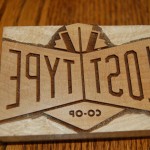
The other major change to making wood type is to use the laser to cut a “Type reading” design into the end grain hard maple slabs I can already produce at exactly type high.
I have several pieces of edge grain laser cut wood type in my collection from friends who also have access to a laser. The difference is by cutting into end-grain the resulting thin impression sections are just as strong as if they were cut on a pantograph. Think of it as a pantograph with a very, very, .003 inch cutter. Sharp corners and NO TRIMMING. I can also cut type down to 2 or 3 line from my existing pantograph files.
The process is not cheap. You have to remove the “smoke and resin” layer that forms on the surface, and you still have to seal them with shellac.  I still cut the majority of my wood type with the pantograph, but it has opened up a whole new area of making printing type.
I still cut the majority of my wood type with the pantograph, but it has opened up a whole new area of making printing type.
As a gift for the Hamilton Wood Type and Printing Museum’s reopening at it’s new location, I cut the Hamilton logo they are currently using in end grain maple. I cut it in several sizes to give them options if they ever decide to use this new type. I also have been cutting state outlines with both the pantograph and laser for my printer friends and special orders. I even laser cut some “Australias” for the Wayzgoose visitors from “Down Under” at the Hamilton Wayzgoose.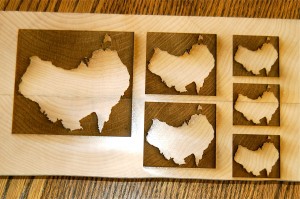
The Hamilton Wood Type and Printing Museum will be hosting this year’s Wayzgoose Letterpress Printing conference November 7th through 10th in their new location. The Museum has moved from it’s historic location on the 1st floor of the several block long, Hamilton complex in Two Rivers, Wisconsin, to a modern unused manufacturing building. If you go to their web site, www.woodtype.org, you can find out more about the move and all the preople around the world who have helped provide funds and labor to make saving the wood type museum possible.
The good people who help to run the museum have been very helpful, and are one of the reasons I have been able to cut wood type. They have provided answers to many of my questions about the entier wood type cutting process, from frozen maple logs to trimmed finished type. They have allowed me to photograph, measure, and experiment with the historical equipment. I have been able to open drawers containing beautiful new type and look at boxes of very old patterns to understand the pattern making process.
I recently spent two days cutting 230 pieces of the same eight pointed historical wood type star to send to Hamilton for the attendee gift bags. The full day of cutting the same piece over and over gave me a little taste of what the real wood type cutters had to deal with during their 12 hours work days in the 1880’s. It was not hard work, but very tedious as I tried to make each piece of wood type perfect and in the shortest amount of time.
Two Rivers, Wisconsin was a factory town. Everyone worked for Hamilton. Some in the old growth forest cutting maple and oak, some in the saw mills and on the assembly lines. Others doing all the hundreds of jobs that comes with running the massive factory.
I will take lots of pictures over the coming Wayzgoose and post them in a few weeks. I also printed two color posters on my daughter’s Vandercook to trade with other printers on the last day of the event.


